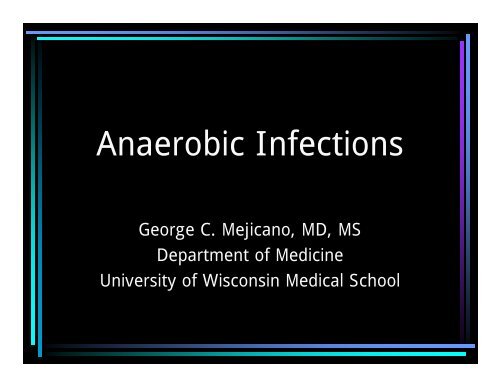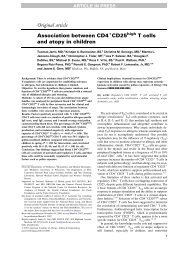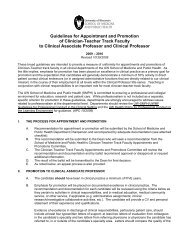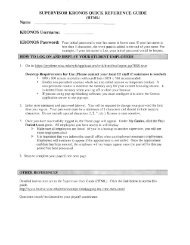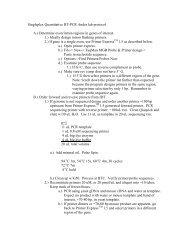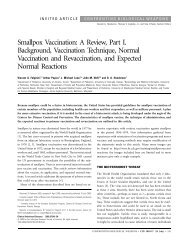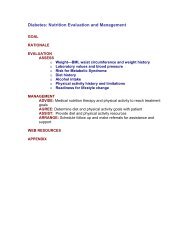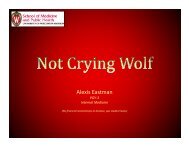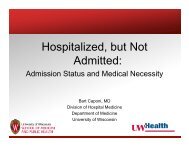Anaerobic Infections
Anaerobic Infections
Anaerobic Infections
Create successful ePaper yourself
Turn your PDF publications into a flip-book with our unique Google optimized e-Paper software.
<strong>Anaerobic</strong> <strong>Infections</strong><br />
George C. Mejicano, MD, MS<br />
Department of Medicine<br />
University of Wisconsin Medical School
An Illustrative Case…<br />
• A 24 year old man had been in good<br />
health when he was awakened with<br />
severe perineal pain.<br />
• He sought medical attention and was<br />
found to have massive scrotal edema.<br />
• The following photo and x-ray were<br />
taken three hours after presentation…
Illustrative Case (continued)…<br />
• Soft tissue radiographs confirmed gas<br />
in the tissues of the thigh, buttocks,<br />
scrotum, and anterior abdominal wall.<br />
• Surgical inspection revealed brownish<br />
fluid in the scrotum, with gray, dullcolored,<br />
friable fascia but normal<br />
underlying musculature.<br />
• Gram stain of the fluid revealed…
Illustrative Case (continued)…<br />
• Intra-operative cultures were obtained<br />
and they grew E. coli, Enterococcus<br />
faecalis, Bacteroides fragilis, and<br />
anaerobic streptococci.<br />
• In addition to surgical drainage, the<br />
patient was treated with ampicillin,<br />
gentamicin, and clindamycin for 3<br />
weeks. He had an excellent clinical<br />
response and had a full recovery.
Definitions<br />
• Aerobe<br />
• Facultative anaerobe<br />
• Anaerobe<br />
• Microaerophile<br />
• Aerotolerance
Aerobes<br />
• Bacteria that can replicate only in the<br />
presence of O 2 (which is the terminal<br />
electron acceptor during respiration)<br />
• Examples:<br />
– Mycobacterium tuberculosis<br />
– Pseudomonas species thrive in<br />
oxygen (but they’re not technically<br />
strict aerobes because they can<br />
use nitrate as the final acceptor)
Facultative Anaerobes<br />
• Bacteria that can replicate in<br />
the presence or absence of O 2<br />
• Very versatile organisms can<br />
use respiration or fermentation<br />
• Examples include many<br />
common bacteria:<br />
– Staphylococcus aureus<br />
– E. coli
Anaerobes<br />
• Bacteria that can replicate only in the<br />
absence of O 2<br />
• Fermenting organisms that use organic<br />
molecules (e.g. pyruvate and acetyl-<br />
CoA) as the terminal electron acceptor<br />
• Generally lack cytochromes, catalase,<br />
and superoxide dismutase<br />
• Examples:<br />
– Clostridium perfringens<br />
– Fusobacterium nucleatum
Microaerophile<br />
• Bacteria that require a reduced<br />
level of O 2 , but are not anaerobic<br />
• These organisms have carved out a<br />
rather specialized niche, such as<br />
the placental-uterine interface<br />
• Example:<br />
– Campylobacter jejuni grows well<br />
in “campy gas” that consists of<br />
85% N 2 , 10% CO 2 , and 5% O 2
Aerotolerance<br />
• Term used to denote the resistance<br />
of anaerobes to killing by exposure<br />
to O 2<br />
• Some organisms are very intolerant<br />
of air and will die very quickly once<br />
exposed to O 2<br />
• Others, even some strict anaerobes,<br />
are somewhat aerotolerant
Importance of Aerotolerance<br />
1. Clinical specimens must be handled<br />
optimally because failure to get a<br />
specimen into an anaerobic medium<br />
jeopardizes the validity of lab results<br />
2. Allows organisms to “hang on” until<br />
the environment turns anaerobic<br />
– Example: B. fragilis possesses both<br />
superoxide dismutase and catalase
Although many organisms can<br />
grow in an anaerobic environment,<br />
the discussion today will focus on<br />
the true anaerobes (also known as<br />
the “strict” or “obligate” anaerobes)
Clinically Significant Anaerobes<br />
• Bacteroides fragilis<br />
– Normal flora of the colon<br />
• Prevotella melaninogenica<br />
– Gingival niche<br />
• Fusobacterium species<br />
– Gingival niche<br />
• Clostridium species<br />
– Normal gut flora; some serious pathogens<br />
• Peptostreptococcus species<br />
– Normal flora of mouth, pharynx, & colon
Bacteroides fragilis
Fusobacterium nucleatum
Clostridium perfringens
Aerobic / <strong>Anaerobic</strong> Sites<br />
• General Conditions<br />
– Skin, muscle, airways, mouth, and<br />
blood are all relatively aerobic sites<br />
– Lumen of both the gastrointestinal<br />
and genitourinary tracts are<br />
relatively anaerobic sites<br />
• Microenvironments<br />
– These are clinically very significant
Concept of Microenvironments<br />
• Aerobic or microaerophilic sites<br />
occur within anaerobic areas<br />
• Examples include the epithelial<br />
surfaces of the GI and GU tracts:<br />
– Intestinal epithelium can support<br />
Pseudomonas aeruginosa<br />
– Placental-uterine interface is ideal<br />
for a microaerophile like C. jejuni
Concept of Microenvironments<br />
• <strong>Anaerobic</strong> microenvironments occur<br />
within aerobic areas<br />
• Often generated by metabolism of<br />
aerobes or facultative organisms<br />
– Gingival crevices<br />
– Tonsils, especially crypts<br />
– Occluded bronchi (allows anaerobic<br />
pneumonia)<br />
– Necrotic area in soft tissues
<strong>Anaerobic</strong> Colonization<br />
• Anaerobes colonize specific<br />
areas and are generally<br />
innocuous, even protective<br />
–Gut<br />
–Mouth<br />
–Genitourinary tract
Normal Gut Flora<br />
• Bacteroides species<br />
– Rare in stomach,<br />
10 3 -10 7 / g in ileum,<br />
10 10 -10 12 / g in colon<br />
– B. fragilis accounts for<br />
< 10% of gut flora, but<br />
is worst opportunist<br />
• Bifidobacterium and<br />
Peptostreptococcus<br />
– Up to 10 12 / g each<br />
• Clostridium species<br />
– 10 6 -10 11 / g<br />
• All facultative and<br />
aerobic organisms<br />
– 10 10 / g combined<br />
• Bottom line is that<br />
anaerobes comprise<br />
> 99% of gut flora
Crucial Concept<br />
Anaerobes occupy living space<br />
(“lebensraum”) and prevent<br />
overgrowth of gut pathogens<br />
such as Clostridium difficile
Normal Mouth Flora<br />
• Usually these anaerobes are harmless<br />
flora that live in the gingival spaces<br />
• Examples:<br />
– Prevotella melaninogenica, Fusobacterium<br />
species, and Peptostreptococcus species<br />
• They may cause periodontal disease &<br />
gingival abscesses, particularly in AIDS
Acute Necrotizing Gingivitis
Normal Genitourinary Flora<br />
• This primarily consists of vaginal flora<br />
since there are few urethral organisms<br />
• Predominant species include:<br />
– Lactobacillus species and<br />
Streptococcus species<br />
• Strict anaerobes present include:<br />
– Prevotella species and<br />
Peptostreptococcus species
Infection and Disease<br />
• Almost all anaerobic infections are<br />
accidental and due to either:<br />
1. Opportunistic overgrowth of normal<br />
flora, or<br />
2. Accidental contamination of wounds<br />
by environmental organisms<br />
• Occasional “food poisoning”<br />
outbreaks due to ingestion of a<br />
preformed toxin (e.g. botulism)
Major Predisposing Condition<br />
• Although anaerobes in blood<br />
occur commonly after bowel<br />
movements & brushing teeth,<br />
establishing an infection nearly<br />
always requires generation of<br />
an anaerobic site
Predisposing Conditions<br />
• Trauma<br />
– Belly wound or a ruptured appendix leads<br />
to spillage of fecal content into peritoneum<br />
• Malignancy<br />
– Example: lung cancer obstructing bronchi<br />
• Loss of circulation<br />
– Usually due to diabetes or vascular disease<br />
• Occlusion of airways or blood vessels<br />
– Examples: foreign body or emboli
Predisposing Conditions<br />
• Unresolved abscess<br />
– Progressively necrotic if left undrained<br />
• Immune collapse<br />
– Outgrowth of oral anaerobes seen in AIDS<br />
• Antibiotic use<br />
– Normal flora disruption allows anaerobic<br />
opportunists such as C. difficile to flourish<br />
• Prosthetic devices<br />
– Propionibacterium acnes infects spine<br />
hardware at poorly vascularized site
Clinical Syndromes<br />
A. Tetanus<br />
B. Botulism<br />
C. Gas gangrene<br />
D. Pseudomembranous<br />
colitis<br />
E. Peritonitis<br />
F. Oral abscess and<br />
periodontal disease<br />
G. Human bite<br />
wounds<br />
H. Brain abscess<br />
I. Aspiration and<br />
necrotizing<br />
pneumonia<br />
J. Bacterial vaginosis,<br />
endometritis and<br />
septic abortion
Tetanus<br />
• Clostridium tetani is found in soil and<br />
the normal gut flora of some mammals<br />
• Organism produces a potent exotoxin<br />
that causes powerful, sustained muscle<br />
contraction resulting in very painful<br />
muscle spasms (“spastic paralysis”)<br />
• Even tiny stimuli trigger spasms<br />
• Common name of disease: “lock jaw”
Facial spasm and risus sardonicus in<br />
a Filipino patient who has tetanus
Tetanospasmin<br />
• Potent exotoxin, tetanospasmin (TS), is<br />
produced by C. tetani at the site of the wound<br />
• The toxin is internalized at the neuromuscular<br />
junction into the alpha motor neuron<br />
• TS then travels by retrograde axonal flow to to<br />
the cell body and diffuses out into the synapses<br />
and extracellular spaces of the CNS<br />
• Its major effect is to inhibit transmitter release<br />
from the presynaptic inhibitory neuron
Tetanus: Treatment and Prevention<br />
• Treatment:<br />
– Keep patient in dark, quiet room<br />
with minimal stimuli<br />
– Muscle relaxants also useful<br />
• Disease now rare due to vaccine<br />
• Predisposing conditions are very<br />
common; thus, healthcare team<br />
must regularly give Td boosters
Wound Classification<br />
Clinical Features<br />
Age of Wound<br />
Configuration<br />
Depth<br />
Mechanism of<br />
Injury<br />
Contaminants<br />
(dirt, saliva, etc.)<br />
Devitalized Tissue<br />
Tetanus Prone<br />
> 6 hours<br />
Stellate, avulsion<br />
> 1 cm<br />
Missile, crush,<br />
burn, or frostbite<br />
Present<br />
Present<br />
Non-Tetanus<br />
Prone<br />
< 6 hours<br />
Linear<br />
< 1 cm<br />
Sharp surface<br />
(glass or knife)<br />
Absent<br />
Absent
Tetanus Prophylaxis<br />
History of<br />
Tetanus Toxoid<br />
Immunization<br />
Clean, Non-<br />
Tetanus Prone<br />
Wounds<br />
Td TIG<br />
Dirty, Tetanus<br />
Prone Wounds<br />
Td TIG<br />
Unknown or<br />
< 3 doses<br />
Yes No<br />
Yes Yes<br />
> 3 doses<br />
No, unless No<br />
10 years<br />
since last<br />
dose<br />
No, unless No<br />
5 years<br />
since last<br />
dose
Botulism<br />
• Due to environmental bacteria: C. botulinum<br />
– Types A, B, E cause majority of human illness<br />
• Organism produces a potent exotoxin,<br />
botulinin, that produces a loss of muscle<br />
tone (descending “flaccid paralysis”)<br />
• Causes distinct illnesses<br />
– Food poisoning leading to flaccid paralysis<br />
– Infant colonization leading to flaccid paralysis<br />
– Infection due to wound botulism is very rare<br />
• Trivalent A, B, E anti-toxin rarely helpful
59 Cases of Botulism: Interval Between<br />
Exposure and Onset of First Neurologic<br />
Symptoms (Michigan, 1977)
Flaccid Paralysis due to Mild Botulism:<br />
Note Disconjugate Gaze, Asymmetric<br />
Smile, and Minimal Smile Creases
Patient Position for Botulism
Gas Gangrene<br />
• Due to Clostridium perfringens and other<br />
Clostridium species<br />
• Pathogenesis factors: most strains produce<br />
α and σ toxins, but only selected strains<br />
produce the enterotoxin of food poisoning<br />
– Lethicinase (α toxin)<br />
– Hemolysin (σ toxin)<br />
• Predisposition: deep, necrotic wounds seen<br />
in war injuries, compound fractures, MVA’s
Gas Gangrene<br />
• Clinical picture: gas crepitation<br />
(crackling sounds over soft tissue)<br />
• Treatment:<br />
– Immediate wound debridement<br />
that may require amputation<br />
– Antibiotics, including clindamycin in<br />
order to decrease toxin production
Case One: Gas Gangrene<br />
• A 35 year old man sustained a knife wound to<br />
the forearm but did not seek immediate care;<br />
36 hours later he experienced severe pain in<br />
the upper arm and presented to the ER.<br />
• The arm was extremely tender and crepitus<br />
was easily demonstrated. A radiograph also<br />
demonstrated gas in the soft tissues.<br />
• Surgical debridement and antibiotics were<br />
instituted, but later amputation at the level of<br />
the shoulder was necessary.
Gram variable rods were seen on<br />
tissue stains; specimens grew a<br />
pure culture of C. perfringens
C. perfringens growing on blood agar in anaerobic environment. Sigma<br />
toxin causes sharp zone of hemolysis nearest the colonies while alpha toxin<br />
(that has lethicinase activity) causes larger zone of partial hemolysis.
Electron Micrograph of C. perfringens<br />
[Note the Endospores]
Case Two: Gas Gangrene<br />
• A 62 year old man suddenly developed<br />
severe pain and swelling in his arm.<br />
• He immediately sought medical attention<br />
and was found to have crepitus over the<br />
affected site. Radiographs confirmed<br />
soft tissue gas.<br />
• Immediate surgical debridement revealed<br />
necrotizing fasciitis, sparing the muscle.
Case Two (continued):<br />
• Cultures grew Clostridium septicum<br />
• Because of the microbiology results, a<br />
colonoscopy was done and this revealed<br />
a mass in the colon. Surgical resection<br />
revealed adenocarcinoma of the colon.<br />
• The malignancy served as the portal of<br />
entry and gas gangrene occurred after<br />
the arm was seeded via the bloodstream.
Pseudomembranous Colitis<br />
• Due to C. difficile, an organism considered<br />
to be a minor member of the normal flora<br />
• Implicated in a huge number of hospital<br />
acquired (nosocomial) infections<br />
• Predisposition: antibiotic disruption of<br />
bowel flora allows organism to flourish<br />
• Pathogenesis<br />
– Toxin A: enterotoxin ordinary diarrhea<br />
– Toxin B: cytotoxin pseudomembranous<br />
colitis
Pseudomembranous Colitis<br />
• Clinical appearance<br />
– Semi-solid diarrhea, fever, abdominal<br />
pain following antibiotic administration<br />
– Pseudomembranes in colon comprised of<br />
fibrin, WBC’s, and necrotic enterocytes<br />
• Treatment<br />
– Withdraw predisposing antibiotic<br />
– Use metronidazole or oral vancomycin
Peritonitis<br />
• Due to a mixture of endogenous<br />
aerobes & anaerobes from the gut<br />
– Anaerobe is commonly B. fragilis and<br />
sometimes Clostridium species but<br />
many others implicated<br />
• Predispositions:<br />
– Penetrating wounds from knives,<br />
bullets, and shrapnel<br />
– Ruptured appendix<br />
– Gut surgery or trauma
Peritonitis<br />
• Clinical appearance<br />
– Inflamed peritoneum causes intense<br />
pain and rebound tenderness<br />
– Life-threatening problem<br />
• Treatment<br />
– Surgical debridement, drainage, and<br />
irrigation, followed by repairing injury<br />
– Broad spectrum antibiotics
Oral Abscess / Peridontal Disease<br />
• Due to mixed aerobic, facultative,<br />
and anaerobic flora<br />
• Anaerobes typically seen include<br />
Fusobacterium, Prevotella, and<br />
Peptostreptococcus species<br />
• Due to low virulence organisms that<br />
act as opportunists as a result of<br />
– Anatomic conditions<br />
– Decreased immunity
Oral Abscess / Periodontal Disease<br />
• Treatment<br />
– Surgical debridement, drainage,<br />
and irrigation<br />
– Broad spectrum antibiotics,<br />
typically penicillin together with<br />
metronidazole
Vestibular<br />
Abscess
Submandibular<br />
Abscess from<br />
Left 2 nd Molar
Bite Wounds<br />
• Human bite wounds are often worse<br />
than animal bite wounds<br />
• Typically caused by Prevotella<br />
melaninogenica, but polymicrobial<br />
infections are common<br />
• Clinical picture<br />
– Very serious, ugly injuries that present<br />
very late due to embarrassment factor
Bite Wounds<br />
• Treatment<br />
– Surgical debridement, drainage,<br />
and irrigation<br />
– Don’t close the wound!<br />
– Broad spectrum antibiotics,<br />
typically amoxicillin-clavulanate<br />
– Consider tetanus prophylaxis
Brain Abscess<br />
• Commonly caused by oral anaerobes<br />
such as Prevotella, Fusobacterium,<br />
and Peptostreptococcus species<br />
• Usually occurs when a local infection<br />
(sinusitis, otitis media, mastoiditis, or<br />
a periorbital abscess) is not contained<br />
• Life threatening infection that<br />
requires prolonged IV antibiotics
Aspiration/Necrotizing Pneumonia<br />
• Commonly caused by oral anaerobes<br />
such as Prevotella, Fusobacterium,<br />
and Peptostreptococcus species<br />
• Typically due to aspiration of saliva<br />
or other oral contents into lung<br />
• Pathogenesis due to occlusion of the<br />
airway followed by generation of an<br />
anaerobic site in lung parenchyma<br />
• Treat with long course of clindamycin
Lung<br />
Abscess
Bacterial Vaginosis<br />
• Common condition in women of child<br />
bearing age<br />
• Associated with Gardnerella vaginalis &<br />
Mobiluncus species, as well as pH > 4.5<br />
• Clinical picture:<br />
– Vaginal discharge that has a fishy odor<br />
– Presence of vaginal epithelial cells (“clue<br />
cells”) confirms the diagnosis<br />
• Rx: clindamycin or metronidazole
Endometritis and Septic Abortion<br />
• Endometritis is essentially the<br />
same thing as gangrene of the<br />
uterus caused by C. perfringens<br />
• Can occur after spontaneous<br />
abortion as well as procedures<br />
• Treat with surgical debridement<br />
(D & C = dilation and curettage)<br />
and antibiotics
Diagnosis of <strong>Anaerobic</strong> <strong>Infections</strong><br />
• Key is obtaining a good specimen<br />
collected into anaerobic medium<br />
• Gram stain sometimes helpful<br />
• Identification may require<br />
specialized procedures<br />
– Gas chromatography in micro lab<br />
– Toxin identification
Glove Box Used to Grow Anaerobes
Prevention of <strong>Anaerobic</strong> <strong>Infections</strong><br />
• Cleanliness helps!<br />
– Aseptic technique, wash hands, and<br />
appropriate antiseptics<br />
• Early and aggressive debridement and<br />
irrigation will save lives<br />
• Use antibiotics appropriately<br />
• Contact isolation for C. difficile<br />
• Tetanus immunization
Treatment of <strong>Anaerobic</strong> <strong>Infections</strong><br />
• Source removal/containment<br />
– Aggressive surgical debridement of<br />
devitalized tissue and infected areas<br />
– Drainage of abscess pockets<br />
• Antisera (immunoglobulin)<br />
– Tetanus immune globulin is important<br />
– Possibly helpful for botulism<br />
• Antibiotics with anaerobic activity
Thank You!!


